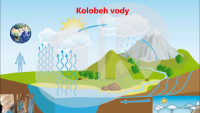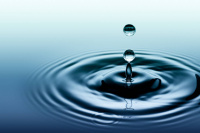water
Water or aqua (chemical formula H2O, according to the traditional name aqueous oxide, newer systematic name oxidane[1]) is a chemical compound of hydrogen and oxygen. It is a basic condition for the existence of life on Earth. At normal temperature and pressure, it is a colorless, clear, odorless and tasteless liquid. It occurs in nature in three states: solid (snow, ice), liquid (water) and gas (water vapor).
It is the most widespread substance on the surface of the Earth. It is an essential component of the biosphere and, along with soil, is of primary importance for ensuring the nutrition of mankind. It makes up 70% of the human body and is essential for plants and animals.
It is a basic component of biomass, the main means for the transport of nutrients, for their intake and excretion.
For plants, not only its total amount per year is important, but also its occurrence and distribution in the growing season due to their growth phases.
For many animals, water is directly the living environment
The structure of water
Water is a chemical compound of two hydrogen atoms (H) and one oxygen atom (O). The atoms in a water molecule are bound by a single polar covalent bond. Intermolecular hydrogen bridges are the cause of e.g. high water boiling temperature of 100 °C.
Water occurs in nature in gas, liquid and solid state.
Because of its dipole character, water is a good solvent for ionic compounds.
Types of waters
According to the content of dissolved mineral substances
Potable - contains a small amount of soluble mineral substances
Distilled - it is free of mineral substances
Soft - contains few minerals
Hard - from underground springs, contains more minerals
Mineral - According to the content of total dissolved solids (RL), natural mineral waters are divided into:
very low mineralized (with RL content up to 50 mg/l)
low mineralized (with an RL content of 50 – 500 mg/l)
moderately mineralized (with an RL content of 500 – 1500 mg/l)
highly mineralized (with an RL content of 1,500-5,000 mg/l)
very highly mineralized (with an RL content of 5,000 – 15,000 mg/l)
brine (with RL content above 15000 mg/l)[2].
According to the purpose of use
Utility - in industrial plants (water hardness is reduced and it gets rid of Ca2+ and Mg2+), in the food industry disinfected water is required (chlorination, ozonation, ultraviolet radiation)
Feed water - water for steam boilers, freed from mineral salts, so as not to form boiler scale that clogs the pipes
Potable - it is suitable for everyday use, it is free of impurities, it contains a balanced amount of mineral substances so that they do not harm health
Wastewater - Wastewater is polluted water produced in industry, agriculture, households, hospitals, laboratories, etc. It is cleaned in wastewater treatment plants. Large factories have their own wastewater treatment plants. Municipalities discharge wastewater to the nearest wastewater treatment plants
By occurrence
surface (lakes, seas, oceans,...)
underground - mineral
precipitation (rain, snow,...)
Features
Physically
Surface tension - is the cause of capillary phenomena, such as heaving of water in the capillaries of soil and rocks, wetting ability, foaming, etc.
Density - increases from 0°C to 3.98°C, then decreases at higher temperature
Viscosity - together with density, significantly affects the hydraulic behavior of water. Its value depends on e.g. water filtration rate through sand, sedimentation rate. It decreases with increasing temperature.
Electrical conductivity - depends on the concentration of ions, their mobility and temperature. The content of dissolved salts and gases increases the conductivity of water.
Thermal capacity – large bodies of water such as lakes, seas, oceans participate in temperature regulation on Earth.
Other properties
Absorption of light
Radioactivity of water
Changes in water communities
Chemical
They are conditioned by the content of dissolved substances in the water.
Sensory
We can detect them with human sense organs. Temperature, color, turbidity, transparency, smell and taste.
Interesting facts
Water Anomaly - At 3.98 °C, it has the highest density. Based on this property, aquatic animals can survive the winter below the surface, as the water does not freeze to the bottom.
During the transition from the liquid to the gaseous state, it increases its volume 1,700 times, thereby performing volumetric work.
March 22 is declared as World Water Day
Water in nature
Occurrence
Water occurs freely in nature in all three states.
Solid
Water in the form of ice and snow occurs at high altitudes, while the height at which ice and snow naturally occurs gradually decreases towards the poles. Almost the entire surface of Antarctica and the Arctic is covered with ice for most of the year. Also, snow and ice occur in large quantities in the temperate zone during winter, when liquid water freezes on its own and precipitation is in the form of snow.
Liquid
In the liquid state, water is found in the largest amount on Earth. It is commonly found in lakes, rivers, streams, oceans and seas, and is found in both soil and swamps. Most of the water is found in the oceans in the form of salt water, covering 71% of the world's surface.
Gaseous
Water vapor is found in the atmosphere and its representation ranges from 1 to 4 percent.
Quantum (provisional name)
The latest discovered state of water that shows signs of a quantum system. In nature, it was found in super-small channels of hexagonal cross-section inside the mineral beryl, varieties of which are also the gems aquamarine and emerald.
Simply put, we can say that tunneling consists in the fact that a particle (in this case a whole water molecule) can overcome a barrier, i.e. j. to tunnel through it and be on both sides of it at the same time, or anywhere inside the barrier.[3]
Water cycle in nature
More information in the main article: The water cycle
The Earth receives radiation from the Sun, the Earth's surface heats up, water turns into steam, which rises into the atmosphere. In the colder environment of the atmosphere, water vapor condenses, forms clouds, falls to the earth's surface in liquid or solid form and immediately begins to flow over it or penetrate it. Part of the fallen precipitation evaporates and continues to circulate.

Water pollution
Water is degraded by chemical substances, petroleum products, heavy metals, radioactive waste, and sewage. Among the biggest sources of pollution are pulp and paper production, oil processing - petroleum hydrocarbons cause odor and taste defects in water.
Human use
Humans use drinking water for their daily needs. Surface water must be treated for drinking water (in water plants). First, solids are allowed to settle, then chemicals are added to the water. These with impurities form a precipitate, flakes are formed that settle to the bottom. Water treated in this way is filtered through a sand filter. The filter catches unsettled flakes and other impurities. However, it does not capture e.g. oils, paints.
Water feature
biological – human nutrition, fauna, flora, climatic and soil factors
health - personal and public hygiene of a person, cleaning, garbage removal, heating, air conditioning, etc.
cultural and aesthetic – landscape beautification


_small.jpeg)